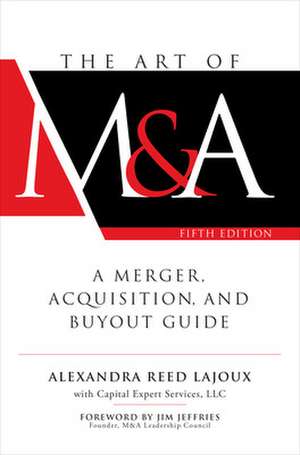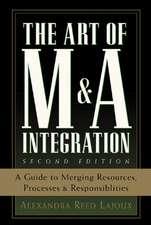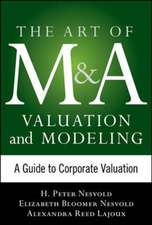The Art of M&A, Fifth Edition: A Merger, Acquisition, and Buyout Guide
Autor Alexandra Reed Lajoux, LLC Capital Expert Servicesen Limba Engleză Hardback – 18 aug 2019
Make every deal a major win! The M&A classic has been updated for today’s business landscape
Since the last edition of this authoritative resource was published, the M&A world has gone from boom to bust and back again—and this new edition brings you completely up to date. With critical lessons learned from the financial crises and regulatory shocks of the past decade, The Art of M&A, Fifth Edition delivers the information and insight you need to make all the right decisions throughout the process. Learn the ins and outs of:
•Getting Started—basic process, requirements, and objectives
• Strategy—deciding what to buy and why
•Valuation and Modeling—measuring and projecting value pre- and post-merger
• Financing and Refinancing—sourcing capital
• Structuring—mitigating financial, tax, and legal risk
• Due Diligence—investigating a business’s past, present, and future risks
• Documentation and Closing—pulling everything together to ensure a smooth transaction
• Integration—merging resources, processes, and responsibilities to maximize synergies
• Landmark Cases—legal cases you need to understand
The Art of M&A is an indispensable resource for anyone heavily engaged in the process—whether you’re an executive tasked with growing your businesses, an investment banker structuring transactions, an attorney responsible for due diligence, or an accountant who advises buyers and sellers. Turn to this definitive resource to develop, steward, and close deals that benefit everyone involved.
Preț: 743.27 lei
Preț vechi: 906.43 lei
-18% Nou
Puncte Express: 1115
Preț estimativ în valută:
142.27€ • 154.59$ • 119.58£
142.27€ • 154.59$ • 119.58£
Carte disponibilă
Livrare economică 31 martie-14 aprilie
Livrare express 15-21 martie pentru 72.54 lei
Preluare comenzi: 021 569.72.76
Specificații
ISBN-13: 9781260121780
ISBN-10: 126012178X
Pagini: 1264
Dimensiuni: 168 x 236 x 57 mm
Greutate: 1.62 kg
Ediția:5
Editura: McGraw Hill Education
Colecția McGraw-Hill
Locul publicării:United States
ISBN-10: 126012178X
Pagini: 1264
Dimensiuni: 168 x 236 x 57 mm
Greutate: 1.62 kg
Ediția:5
Editura: McGraw Hill Education
Colecția McGraw-Hill
Locul publicării:United States
Cuprins
FOREWORD
PREFACE AND ACKNOWLEDGMENTS
Chapter 1 Getting Started in Mergers and Acquisition
Introduction • Key Terms • About Our Question-and-Answer Format • Concluding Comments • Exhibit 1-1: Global M&A Transaction Value (1988 vs. 2018) • Exhibit 1-2: The M&A Process • Notes
Chapter 2 Strategy
Introduction • Strategic Planning • The Role of M&A in Strategic
Planning • Alternatives to M&A • SWOT Analysis • Disclosure of
Strategy • Levels of Strategy • Four Types of M&A Strategy • The Search
Process • Brokers and Finders • Bankers • Initial Regulatory and Legal
Considerations • Concluding Comments • Exhibit 2-1: Outline for a Typical
Strategic Plan • Exhibit 2-2: M&A in a Strategic Decision Tree • Exhibit 2-3:
Range of Structure for Business Collaboration • Exhibit 2-4: Sample SWOT
Analysis Questions • Exhibit 2-5: Sample Checklist of Assets for Use in
Complement/Supplement Analysis • Exhibit 2-6: Sample Checklist of Risks for
Use in Seeking Complementary Acquisitions • Exhibit 2-7: Sample Strategy
Statements • Exhibit 2-8: What Is Alphabet? • Exhibit 2-9: Examples of
Options Embedded in Strategic Acquisitions • Exhibit 2-10: The AI Acquisition
Race • Exhibit 2-11: Sherwin-Williams—Vertical Strategy Leads to Horizontal
Move • Exhibit 2-12: A Guide to M&A Decisions • Exhibit 2-13: Opportunity
Prioritization • Exhibit 2-14: Premerger Notification Thresholds Under Hart-
Scott-Rodino • Appendix 2A: Types of Organizational Structure • Appendix 2B: Checklist of Assets • Appendix 2C: Horizontal Merger Guidelines • Appendix 2D: Tesoro Strikes Gold in California • Notes
Chapter 3 Valuation and Modeling
Introduction • Valuation Fundamentals • Choosing a Valuation Approach • Comparable Companies and Transactions • Comparable Transactions Analysis • DCF Analysis • Forecasting Free Cash Flow • Calculating the Discount Rate • Ascribing a Terminal Value • Conducting Sensitivity
Analyses • The IVS Framework • Concluding Comments • Exhibit 3-1: Valuation Approaches • Exhibit 3-2: Advantages and Disadvantages of Valuation Multiples • Exhibit 3-3: Common Multiples Used in Selected Sectors • Exhibit 3-4: Comparable Companies Checklist • Exhibit 3-5: Variations in Accounting May Affect Valuation Multiples • Exhibit 3-6: Comparable Transactions Checklist • Exhibit 3-7: Summary of Precedent Transactions • Exhibit 3-8: Overview of the DCF Analysis Process • Exhibit 3-9: Advantages of DCF Analysis • Exhibit 3-10: Disadvanatges of DCF Analysis • Exhibit 3-11: Defining Free Cash Flow—Top-down Approach • Exhibit 3-12: Calculating Free Cash Flow—Example of Top-down Approach • Exhibit 3-13: Defining Free Cash Flow—Bottom-up Approach • Exhibit 3-14: Calculating Free Cash Flow—Example of Bottom-up Approach • Exhibit 3-15: Present Value Formula • Exhibit 3-16: WACC Formula • Exhibit 3-17: Cost of Common Equity Formula • Exhibit 3-18: Chart Showing Size Premiums by Quartile and Decile • Exhibit 3-19: Chart Showing Size Premiums by Decile • Exhibit 3-20: Exit Multiple Approach to Estimating Terminal Value • Exhibit 3-21: Terminal Value Model Assuming Constant Growth • Exhibit 3-22: Perpetuity Value Assuming No Growth in Cash Flows • Exhibit 3-23: Perpetuity Value Assuming 2 Percent Growth • Exhibit 3-24: DCF for a Business Already in Constant Growth Mode • Exhibit 3-25: DCF for a No. 2 Pencil Manufacturer • Notes
Chapter 4 Financing and Refinancing
Introduction • Financing Overview • Financing Instruments: Equity vs. Debt vs. Hybrids • Financing Sources • Highly Leveraged Transactions • Minimizing Borrowing • Determining Structure in Debt Financing • Senior Debt • Sale-Leasebacks • Pros and Cons of Preserving Debt and Lease Obligations • Seller Takeback Financing • Warrants • Working Capital Debt of the Seller • The Bank Book and Commitment Letter • Other Principal Issues in Senior Loan Agreements • High-Yield (a.k.a. “Junk”) Bonds • Bridge Loans • Equity Investment Funds • Registration Rights • Intercreditor Issues • Subordination Issues • Intercreditor Agreements • Fraudulent Conveyance and Other Litigation Concerns • Refinancing Issues • Concluding Comments • Exhibit 4-1: The LBO of Beatrice and Its Aftermath • Exhibit 4-2: Sample Company’s Cash Flow and Debt Service Requirements • Exhibit 4-3: Sample Covenant • Exhibit 4-4: Subordination and Corporate Structure • Appendix 4A: Typical Subordination Provisions of Publicly Issued Notes • Appendix 4B: Typical Subordination Provisions of Privately Placed Institutional Notes • Appendix 4C: Typical Subordination Provisions of Seller Notes • Notes
Chapter 5 Structuring Transactions: General, Tax, and Accounting Considerations
Introduction • General Considerations • Structuring Asset Transactions • Structuring Stock Transactions • Structuring Merger Transactions • General Accounting Considerations • Allocating the Price of a Transaction for Accounting Purposes • Difference Between Accounting and Tax Treatments • Tax Considerations • Basic Tax Concepts and Definitions • Basic Tax Structure: Taxable Transactions • Basic Tax Structure: Tax-Deferred Transactions • Choice of Entity • Tax Consequences in Structuring Acquisition
Debt Financing • Management Buyout Tax Basics • Postacquisition Tax Issues • Other Tax Issues • Concluding Comments • Transaction Diagrams • Exhibit 5-1: A Guide to US (Federal) and State Codes • Exhibit 5-2: Forward Subsidiary Merger (FSM) vs. Reverse Subsidiary Merger (RSM) • Exhibit 5-3: Anatomy of a Merger, Acquisition, and Buyout Transaction • Exhibit 5-4: Description of Acquisition Allocation from Emcor Group, Inc. • Exhibit 5-5: Differences in the Purchase Price Computation • Exhibit 5-6: Section 368: Types of Reorganization • Exhibit 5-7: Stock Purchase • Exhibit 5-8: Asset Purchase • Exhibit 5-9: Taxable Forward Merger • Exhibit 5-10: Taxable Reverse Merger • Exhibit 5-11: Taxable Forward Subsidiary Merger • Exhibit 5-12: Tax-Free Forward Merger (A Reorganization) • Exhibit 5-13: Tax-Free Forward Triangular Merger • Exhibit 5-14: Tax-Free Acquisition of Stock for Voting Stock (B Reorganization) • Exhibit 5-15: Acquisition of Property for Voting Stock (C Reorganization) • Exhibit 5-16: Acquisition of Property for Voting Stock (D Reorganization) • Exhibit 5-17: National Starch Transaction (Section 351 Acquisition) • Appendix 5A: Meeting the Reorganization Test: US Examples from the Internal Revenue Service • Notes
Chapter 6 The Due Diligence Inquiry
Introduction • Getting Started • Duration of Due Diligence • Due Diligence Levels • Securities Laws and Due Diligence • Red Flags • Relations with the Seller • Location of Due Diligence Research • Evaluating Assets • Litigation Analysis • Emerging Legal Issues • Due Diligence After Closing • Concluding Comments • Exhibit 6-1: VDR Menu Screen Shot • Exhibit 6-2: A Representative List of Virtual Data Room Providers • Exhibit 6-3: Some Typical Plaintiff Claims in M&A Litigation • Exhibit 6-4: Venn Diagram Showing Interrelationship of M&A, Due Diligence Standards, and Securities Law • Appendix 6A: Sample Confidentiality Agreement • Appendix 6B: Due Diligence Checklist • Appendix 6C: An Annotated Initial Document and Information Request List • Appendix 6D: Sample Index of VDR Documents • Notes
Chapter 7 Negotiating the Letter of Intent and Acquisition Agreement
Introduction • Letter of Intent • The Acquisition Agreement • Components of the Agreement • Introductory Material • Representations and Warranties • Covenants • Conditions to Closing • Indemnity Section • Acquisitions from an Affiliated Group • Transactions Involving Public Companies • Negotiating and Documenting an MBO • Employment Agreements • Stockholders’ Agreements • Concluding Comments • Exhibit 7-1: Seller vs. Buyer Key Goals • Exhibit 7-2: The Safeguards-Price Negotiating Matrix • Exhibit 7-3: The FASB on Materiality • Appendix 7A: Sample Letter of Intent • Appendix 7B:Typical Merger Agreement and Commentary • Notes
Chapter 8 Closing
Introduction • The Basics of Closing • Planning the Closing • Preclosing • Closing • Wire Transfers • Postclosing • Concluding
Comments • Appendix 8A: Sample Closing Memorandum (Including a Detailed Schedule of Closing Documents) • Notes
Chapter 9 Postmerger Integration and Divestitures
Introduction • Basic Concepts of Integration • The Postmerger Plan • Communicating the Integration Plan • Combining Company Names • Integrating Cultures • Integrating Mission, Policy, Ethics, and Vision Statements • Integrating Key Resources, Processes, and Responsibilities • Integrating Resources • Integrating Processes • Integrating Responsibilities • Commitments to Employees • Postmerger Compensation: A Complex Issue • Planning Pay Integration: A Strategic Overview • Merging Benefits Plans • Some General Postmerger Technology Considerations • Divestitures • Concluding Comments • Exhibit 9-1: Audience Media Communications Matrix • Exhibit 9-2: Steps for Naming a Newly Combined Company • Exhibit 9-3: A Matrix for Planning Cultural Integration • Exhibit 9-4: Acquisition Integration Plan for Human Resources Operation • Exhibit 9-5: Three Brand Approaches • Exhibit 9-6: Sample Plan for 30-, 60-, and 90+-Day Milestones • Exhibit 9-7: Old Line Bank and Bay Bank Merger FAQ (Excerpts) • Exhibit 9-8: Marathon Patent Press Release Addressing the Dilution Issue • Exhibit 9-9: Sample Matrix for Postmerger Compensation Planning • Exhibit 9-10: Valuing the Divestiture Option • Exhibit 9-11: The WARN Act: Basic Provisions/Requirements • Appendix 9A: Sample Postmerger Press Release Highlighting Strategic Motivation • Appendix 9B: Sample “Assets” Checklist of Resources, Processes, and Responsibilities • Appendix 9C: Integration Planning Worksheet • Appendix 9D: Integration Timeline from a Midsized Acquirer • Appendix 9E: Pairwise Comparison • Appendix 9F: Principles for Responsible Business • Exhibit 9E-1: Setting Up the Pairwise Comparison Matrix • Exhibit 9E-2: Identifying the Useful Part of the Matrix • Exhibit 9E-3: Filling the Useful Part of the Matrix • Notes
Chapter 10 Special Issues for M&A in Public Companies
Introduction • General Considerations • Proxy Voting • Dodd-Frank, Sarbanes-Oxley, and M&A • Duties of Care and Loyalty • Director Responsibilities in Responding to Unsolicited Bids • M&A Forms • Tender Offer Basics • Proxy Solicitations • Going Private • Merger Disclosure Issues • Insider Trading • Financing the Two-Step Public Transaction with Debt • Takeover Defenses • State Laws Related to Takeover Defense • Concluding Comments • Exhibit 10-1: Some Typical Plaintiff Claims in M&A Litigation • Exhibit 10-2: Federal Class Actions on M&A 2010–2018 • Exhibit 10-3: Likely Responses to Tender Offers Versus Management Promises • Notes
Chapter 11 Workouts, Bankruptcies, and Liquidations
Introduction • General Considerations • Workouts • Bankruptcy • State Insolvency Proceedings • Investing Opportunities: Structuring the Purchase of a Troubled Company • Structuring a Buyout to Minimize Insolvency
Risk • Financing Alternatives for Companies with Losses • Accounting/Tax Issues for Companies with Losses • Liquidation • Concluding Comments • Diagrams Showing Various Structures for Reorganizations and Workouts of Insolvent Companies • Exhibit 11-1: Definitions of Bankruptcy • Exhibit 11-2: Average Corporate Debt Recovery Rates Measured by Ultimate Recoveries, 1987–2018 • Exhibit 11-3: Business vs. Computer Bankruptcies • Exhibit 11-4: Some Common Consolidation Scenarios Applying ASC 810 • Exhibit 11-5: The 10 Largest Bankruptcies in the United States (by Total Assets Pre-Bankruptcy) • Exhibit 11-6: Structure Posing No Fraudulent Conveyance Risk • Exhibit 11-7: Structure Posing Fraudulent Conveyance Risk via Guarantee • Exhibit 11-8: Structure Posing Fraudulent Conveyance Risk via Transfer of Loan Recipient • Exhibit 11-9: Structure Posing Fraudulent Conveyance Risk via Simple Merger • Exhibit 11-10: Structure Posing Fraudulent Conveyance Risk via Distribution to Target Shareholder • Exhibit 11-11: Structure Posing Risk of Fraudulent Conveyance in Multistep Transaction Involving Small Stock Purchase and Large Loan • Exhibit 11-12: Structure Posing Fraudulent Conveyance Risk via Transfer of Risk to a Subsidiary • Notes
Chapter 12 Global Deals: Structuring for Success
Introduction • Nontax Inbound: Issues Regarding Foreign Investment in the United States • Nontax Outbound: Acquisitions Involving Assets Located Outside the United States • Foreign Exchange • Other Global Realities • Financing Outbound Transactions • International Tax and Disclosure Considerations • Tax Considerations in Inbound Acquisitions • Tax Considerations in Outbound Acquisitions • Concluding Comments • Exhibit 12-1: Examples of Eurocurrencies • Appendix 12-1:Meeting the Reorganization Test: Foreign Examples from the Internal Revenue Service • Notes
Landmark and Recent M&A Legal Cases
Cases Alleging Impropriety in Purchasing (or Disclosing an Offer to Purchase) a Company or Controlling Shares • Cases Alleging Impropriety in the Valuation and/or Sale of a Business, Assets, or Controlling Shares • Cases Involving M&A Agreements or Other Contracts • Cases Alleging Violation of Antitrust Laws • Cases Alleging Violations of Health, Safety, and Labor Laws in an M&A Context • Cases Dealing with Jurisdiction or Right to Sue Following a Merger • Additional Cases
INDEX
PREFACE AND ACKNOWLEDGMENTS
Chapter 1 Getting Started in Mergers and Acquisition
Introduction • Key Terms • About Our Question-and-Answer Format • Concluding Comments • Exhibit 1-1: Global M&A Transaction Value (1988 vs. 2018) • Exhibit 1-2: The M&A Process • Notes
Chapter 2 Strategy
Introduction • Strategic Planning • The Role of M&A in Strategic
Planning • Alternatives to M&A • SWOT Analysis • Disclosure of
Strategy • Levels of Strategy • Four Types of M&A Strategy • The Search
Process • Brokers and Finders • Bankers • Initial Regulatory and Legal
Considerations • Concluding Comments • Exhibit 2-1: Outline for a Typical
Strategic Plan • Exhibit 2-2: M&A in a Strategic Decision Tree • Exhibit 2-3:
Range of Structure for Business Collaboration • Exhibit 2-4: Sample SWOT
Analysis Questions • Exhibit 2-5: Sample Checklist of Assets for Use in
Complement/Supplement Analysis • Exhibit 2-6: Sample Checklist of Risks for
Use in Seeking Complementary Acquisitions • Exhibit 2-7: Sample Strategy
Statements • Exhibit 2-8: What Is Alphabet? • Exhibit 2-9: Examples of
Options Embedded in Strategic Acquisitions • Exhibit 2-10: The AI Acquisition
Race • Exhibit 2-11: Sherwin-Williams—Vertical Strategy Leads to Horizontal
Move • Exhibit 2-12: A Guide to M&A Decisions • Exhibit 2-13: Opportunity
Prioritization • Exhibit 2-14: Premerger Notification Thresholds Under Hart-
Scott-Rodino • Appendix 2A: Types of Organizational Structure • Appendix 2B: Checklist of Assets • Appendix 2C: Horizontal Merger Guidelines • Appendix 2D: Tesoro Strikes Gold in California • Notes
Chapter 3 Valuation and Modeling
Introduction • Valuation Fundamentals • Choosing a Valuation Approach • Comparable Companies and Transactions • Comparable Transactions Analysis • DCF Analysis • Forecasting Free Cash Flow • Calculating the Discount Rate • Ascribing a Terminal Value • Conducting Sensitivity
Analyses • The IVS Framework • Concluding Comments • Exhibit 3-1: Valuation Approaches • Exhibit 3-2: Advantages and Disadvantages of Valuation Multiples • Exhibit 3-3: Common Multiples Used in Selected Sectors • Exhibit 3-4: Comparable Companies Checklist • Exhibit 3-5: Variations in Accounting May Affect Valuation Multiples • Exhibit 3-6: Comparable Transactions Checklist • Exhibit 3-7: Summary of Precedent Transactions • Exhibit 3-8: Overview of the DCF Analysis Process • Exhibit 3-9: Advantages of DCF Analysis • Exhibit 3-10: Disadvanatges of DCF Analysis • Exhibit 3-11: Defining Free Cash Flow—Top-down Approach • Exhibit 3-12: Calculating Free Cash Flow—Example of Top-down Approach • Exhibit 3-13: Defining Free Cash Flow—Bottom-up Approach • Exhibit 3-14: Calculating Free Cash Flow—Example of Bottom-up Approach • Exhibit 3-15: Present Value Formula • Exhibit 3-16: WACC Formula • Exhibit 3-17: Cost of Common Equity Formula • Exhibit 3-18: Chart Showing Size Premiums by Quartile and Decile • Exhibit 3-19: Chart Showing Size Premiums by Decile • Exhibit 3-20: Exit Multiple Approach to Estimating Terminal Value • Exhibit 3-21: Terminal Value Model Assuming Constant Growth • Exhibit 3-22: Perpetuity Value Assuming No Growth in Cash Flows • Exhibit 3-23: Perpetuity Value Assuming 2 Percent Growth • Exhibit 3-24: DCF for a Business Already in Constant Growth Mode • Exhibit 3-25: DCF for a No. 2 Pencil Manufacturer • Notes
Chapter 4 Financing and Refinancing
Introduction • Financing Overview • Financing Instruments: Equity vs. Debt vs. Hybrids • Financing Sources • Highly Leveraged Transactions • Minimizing Borrowing • Determining Structure in Debt Financing • Senior Debt • Sale-Leasebacks • Pros and Cons of Preserving Debt and Lease Obligations • Seller Takeback Financing • Warrants • Working Capital Debt of the Seller • The Bank Book and Commitment Letter • Other Principal Issues in Senior Loan Agreements • High-Yield (a.k.a. “Junk”) Bonds • Bridge Loans • Equity Investment Funds • Registration Rights • Intercreditor Issues • Subordination Issues • Intercreditor Agreements • Fraudulent Conveyance and Other Litigation Concerns • Refinancing Issues • Concluding Comments • Exhibit 4-1: The LBO of Beatrice and Its Aftermath • Exhibit 4-2: Sample Company’s Cash Flow and Debt Service Requirements • Exhibit 4-3: Sample Covenant • Exhibit 4-4: Subordination and Corporate Structure • Appendix 4A: Typical Subordination Provisions of Publicly Issued Notes • Appendix 4B: Typical Subordination Provisions of Privately Placed Institutional Notes • Appendix 4C: Typical Subordination Provisions of Seller Notes • Notes
Chapter 5 Structuring Transactions: General, Tax, and Accounting Considerations
Introduction • General Considerations • Structuring Asset Transactions • Structuring Stock Transactions • Structuring Merger Transactions • General Accounting Considerations • Allocating the Price of a Transaction for Accounting Purposes • Difference Between Accounting and Tax Treatments • Tax Considerations • Basic Tax Concepts and Definitions • Basic Tax Structure: Taxable Transactions • Basic Tax Structure: Tax-Deferred Transactions • Choice of Entity • Tax Consequences in Structuring Acquisition
Debt Financing • Management Buyout Tax Basics • Postacquisition Tax Issues • Other Tax Issues • Concluding Comments • Transaction Diagrams • Exhibit 5-1: A Guide to US (Federal) and State Codes • Exhibit 5-2: Forward Subsidiary Merger (FSM) vs. Reverse Subsidiary Merger (RSM) • Exhibit 5-3: Anatomy of a Merger, Acquisition, and Buyout Transaction • Exhibit 5-4: Description of Acquisition Allocation from Emcor Group, Inc. • Exhibit 5-5: Differences in the Purchase Price Computation • Exhibit 5-6: Section 368: Types of Reorganization • Exhibit 5-7: Stock Purchase • Exhibit 5-8: Asset Purchase • Exhibit 5-9: Taxable Forward Merger • Exhibit 5-10: Taxable Reverse Merger • Exhibit 5-11: Taxable Forward Subsidiary Merger • Exhibit 5-12: Tax-Free Forward Merger (A Reorganization) • Exhibit 5-13: Tax-Free Forward Triangular Merger • Exhibit 5-14: Tax-Free Acquisition of Stock for Voting Stock (B Reorganization) • Exhibit 5-15: Acquisition of Property for Voting Stock (C Reorganization) • Exhibit 5-16: Acquisition of Property for Voting Stock (D Reorganization) • Exhibit 5-17: National Starch Transaction (Section 351 Acquisition) • Appendix 5A: Meeting the Reorganization Test: US Examples from the Internal Revenue Service • Notes
Chapter 6 The Due Diligence Inquiry
Introduction • Getting Started • Duration of Due Diligence • Due Diligence Levels • Securities Laws and Due Diligence • Red Flags • Relations with the Seller • Location of Due Diligence Research • Evaluating Assets • Litigation Analysis • Emerging Legal Issues • Due Diligence After Closing • Concluding Comments • Exhibit 6-1: VDR Menu Screen Shot • Exhibit 6-2: A Representative List of Virtual Data Room Providers • Exhibit 6-3: Some Typical Plaintiff Claims in M&A Litigation • Exhibit 6-4: Venn Diagram Showing Interrelationship of M&A, Due Diligence Standards, and Securities Law • Appendix 6A: Sample Confidentiality Agreement • Appendix 6B: Due Diligence Checklist • Appendix 6C: An Annotated Initial Document and Information Request List • Appendix 6D: Sample Index of VDR Documents • Notes
Chapter 7 Negotiating the Letter of Intent and Acquisition Agreement
Introduction • Letter of Intent • The Acquisition Agreement • Components of the Agreement • Introductory Material • Representations and Warranties • Covenants • Conditions to Closing • Indemnity Section • Acquisitions from an Affiliated Group • Transactions Involving Public Companies • Negotiating and Documenting an MBO • Employment Agreements • Stockholders’ Agreements • Concluding Comments • Exhibit 7-1: Seller vs. Buyer Key Goals • Exhibit 7-2: The Safeguards-Price Negotiating Matrix • Exhibit 7-3: The FASB on Materiality • Appendix 7A: Sample Letter of Intent • Appendix 7B:Typical Merger Agreement and Commentary • Notes
Chapter 8 Closing
Introduction • The Basics of Closing • Planning the Closing • Preclosing • Closing • Wire Transfers • Postclosing • Concluding
Comments • Appendix 8A: Sample Closing Memorandum (Including a Detailed Schedule of Closing Documents) • Notes
Chapter 9 Postmerger Integration and Divestitures
Introduction • Basic Concepts of Integration • The Postmerger Plan • Communicating the Integration Plan • Combining Company Names • Integrating Cultures • Integrating Mission, Policy, Ethics, and Vision Statements • Integrating Key Resources, Processes, and Responsibilities • Integrating Resources • Integrating Processes • Integrating Responsibilities • Commitments to Employees • Postmerger Compensation: A Complex Issue • Planning Pay Integration: A Strategic Overview • Merging Benefits Plans • Some General Postmerger Technology Considerations • Divestitures • Concluding Comments • Exhibit 9-1: Audience Media Communications Matrix • Exhibit 9-2: Steps for Naming a Newly Combined Company • Exhibit 9-3: A Matrix for Planning Cultural Integration • Exhibit 9-4: Acquisition Integration Plan for Human Resources Operation • Exhibit 9-5: Three Brand Approaches • Exhibit 9-6: Sample Plan for 30-, 60-, and 90+-Day Milestones • Exhibit 9-7: Old Line Bank and Bay Bank Merger FAQ (Excerpts) • Exhibit 9-8: Marathon Patent Press Release Addressing the Dilution Issue • Exhibit 9-9: Sample Matrix for Postmerger Compensation Planning • Exhibit 9-10: Valuing the Divestiture Option • Exhibit 9-11: The WARN Act: Basic Provisions/Requirements • Appendix 9A: Sample Postmerger Press Release Highlighting Strategic Motivation • Appendix 9B: Sample “Assets” Checklist of Resources, Processes, and Responsibilities • Appendix 9C: Integration Planning Worksheet • Appendix 9D: Integration Timeline from a Midsized Acquirer • Appendix 9E: Pairwise Comparison • Appendix 9F: Principles for Responsible Business • Exhibit 9E-1: Setting Up the Pairwise Comparison Matrix • Exhibit 9E-2: Identifying the Useful Part of the Matrix • Exhibit 9E-3: Filling the Useful Part of the Matrix • Notes
Chapter 10 Special Issues for M&A in Public Companies
Introduction • General Considerations • Proxy Voting • Dodd-Frank, Sarbanes-Oxley, and M&A • Duties of Care and Loyalty • Director Responsibilities in Responding to Unsolicited Bids • M&A Forms • Tender Offer Basics • Proxy Solicitations • Going Private • Merger Disclosure Issues • Insider Trading • Financing the Two-Step Public Transaction with Debt • Takeover Defenses • State Laws Related to Takeover Defense • Concluding Comments • Exhibit 10-1: Some Typical Plaintiff Claims in M&A Litigation • Exhibit 10-2: Federal Class Actions on M&A 2010–2018 • Exhibit 10-3: Likely Responses to Tender Offers Versus Management Promises • Notes
Chapter 11 Workouts, Bankruptcies, and Liquidations
Introduction • General Considerations • Workouts • Bankruptcy • State Insolvency Proceedings • Investing Opportunities: Structuring the Purchase of a Troubled Company • Structuring a Buyout to Minimize Insolvency
Risk • Financing Alternatives for Companies with Losses • Accounting/Tax Issues for Companies with Losses • Liquidation • Concluding Comments • Diagrams Showing Various Structures for Reorganizations and Workouts of Insolvent Companies • Exhibit 11-1: Definitions of Bankruptcy • Exhibit 11-2: Average Corporate Debt Recovery Rates Measured by Ultimate Recoveries, 1987–2018 • Exhibit 11-3: Business vs. Computer Bankruptcies • Exhibit 11-4: Some Common Consolidation Scenarios Applying ASC 810 • Exhibit 11-5: The 10 Largest Bankruptcies in the United States (by Total Assets Pre-Bankruptcy) • Exhibit 11-6: Structure Posing No Fraudulent Conveyance Risk • Exhibit 11-7: Structure Posing Fraudulent Conveyance Risk via Guarantee • Exhibit 11-8: Structure Posing Fraudulent Conveyance Risk via Transfer of Loan Recipient • Exhibit 11-9: Structure Posing Fraudulent Conveyance Risk via Simple Merger • Exhibit 11-10: Structure Posing Fraudulent Conveyance Risk via Distribution to Target Shareholder • Exhibit 11-11: Structure Posing Risk of Fraudulent Conveyance in Multistep Transaction Involving Small Stock Purchase and Large Loan • Exhibit 11-12: Structure Posing Fraudulent Conveyance Risk via Transfer of Risk to a Subsidiary • Notes
Chapter 12 Global Deals: Structuring for Success
Introduction • Nontax Inbound: Issues Regarding Foreign Investment in the United States • Nontax Outbound: Acquisitions Involving Assets Located Outside the United States • Foreign Exchange • Other Global Realities • Financing Outbound Transactions • International Tax and Disclosure Considerations • Tax Considerations in Inbound Acquisitions • Tax Considerations in Outbound Acquisitions • Concluding Comments • Exhibit 12-1: Examples of Eurocurrencies • Appendix 12-1:Meeting the Reorganization Test: Foreign Examples from the Internal Revenue Service • Notes
Landmark and Recent M&A Legal Cases
Cases Alleging Impropriety in Purchasing (or Disclosing an Offer to Purchase) a Company or Controlling Shares • Cases Alleging Impropriety in the Valuation and/or Sale of a Business, Assets, or Controlling Shares • Cases Involving M&A Agreements or Other Contracts • Cases Alleging Violation of Antitrust Laws • Cases Alleging Violations of Health, Safety, and Labor Laws in an M&A Context • Cases Dealing with Jurisdiction or Right to Sue Following a Merger • Additional Cases
INDEX




















